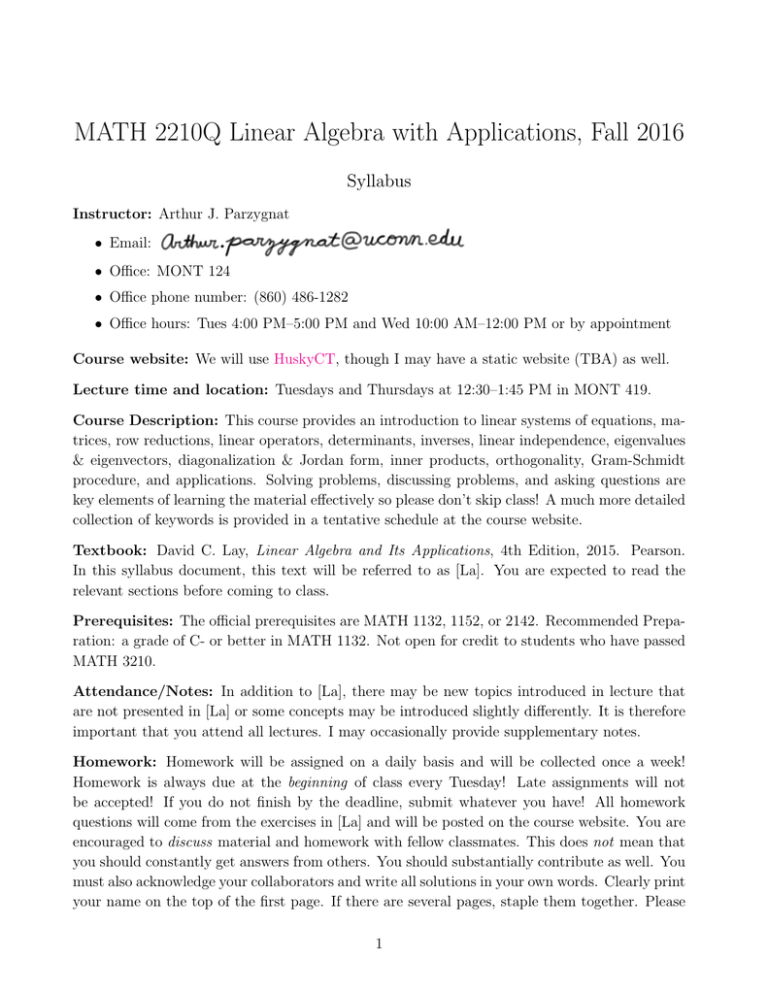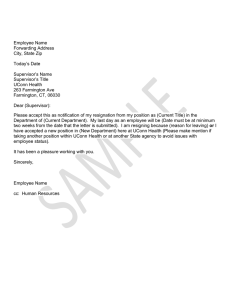MATH 2210Q Linear Algebra with Applications, Fall 2016
advertisement

MATH 2210Q Linear Algebra with Applications, Fall 2016 Syllabus Instructor: Arthur J. Parzygnat • Email: • Office: MONT 124 • Office phone number: (860) 486-1282 • Office hours: Tues 4:00 PM–5:00 PM and Wed 10:00 AM–12:00 PM or by appointment Course website: We will use HuskyCT, though I may have a static website (TBA) as well. Lecture time and location: Tuesdays and Thursdays at 12:30–1:45 PM in MONT 419. Course Description: This course provides an introduction to linear systems of equations, matrices, row reductions, linear operators, determinants, inverses, linear independence, eigenvalues & eigenvectors, diagonalization & Jordan form, inner products, orthogonality, Gram-Schmidt procedure, and applications. Solving problems, discussing problems, and asking questions are key elements of learning the material effectively so please don’t skip class! A much more detailed collection of keywords is provided in a tentative schedule at the course website. Textbook: David C. Lay, Linear Algebra and Its Applications, 4th Edition, 2015. Pearson. In this syllabus document, this text will be referred to as [La]. You are expected to read the relevant sections before coming to class. Prerequisites: The official prerequisites are MATH 1132, 1152, or 2142. Recommended Preparation: a grade of C- or better in MATH 1132. Not open for credit to students who have passed MATH 3210. Attendance/Notes: In addition to [La], there may be new topics introduced in lecture that are not presented in [La] or some concepts may be introduced slightly differently. It is therefore important that you attend all lectures. I may occasionally provide supplementary notes. Homework: Homework will be assigned on a daily basis and will be collected once a week! Homework is always due at the beginning of class every Tuesday! Late assignments will not be accepted! If you do not finish by the deadline, submit whatever you have! All homework questions will come from the exercises in [La] and will be posted on the course website. You are encouraged to discuss material and homework with fellow classmates. This does not mean that you should constantly get answers from others. You should substantially contribute as well. You must also acknowledge your collaborators and write all solutions in your own words. Clearly print your name on the top of the first page. If there are several pages, staple them together. Please 1 write clearly, legibly, and in an organized manner. You are encouraged to type your solutions using LATEX. Avoid plagiarism and read (and abide by) the student code, including the section on Academic Integrity available at http://community.uconn.edu/the-student-code-appendix-a/. Quizzes: There will be short 10–15 minute quizzes at the beginning of class every Thursday unless specified otherwise. The questions will be based on the material covered the week before. Exams: There will be two exams mid semester and one final. The date of the final will be provided as soon as it becomes available to the instructor. Grading: Habitual tardiness (which disrupts the class) and skipping of class will negatively affect your grade. The approximate distribution of grades is given in this table: Quizzes Homework Two (mid-term) exams Final 15% 15% 20% each 30% Grade conversion chart: % 93-100 90-92 87-89 83-86 80-82 77-79 73-76 70-72 67-69 63-66 60-62 < 60 Letter A AB+ B BC+ C CD+ D DF More information about grades can be found at http://catalog.uconn.edu/academic-regulations/gradeinformation. Please refrain from asking questions about grades outside of the first day of class as it distracts the students from the material of the class. Secondary references: • Gilbert Strang’s video lectures from OCW at MIT: Gilbert Strang. 18.06 Linear Algebra. Spring 2010. Massachusetts Institute of Technology: MIT OpenCourseWare, http://ocw.mit.edu. License: Creative Commons BY-NC-SA. • Tom Roby’s lectures and notes http://www.math.uconn.edu/~troby/Math2210F13/ • For those who want a more rigorous introduction to linear algebra, I highly recommend Paul Halmos’ Finite Dimensional Vector Spaces. 1942. Princeton University Press. Programming: Occasionally, we may implement some graphical programs for visualizations such as MatLab or Mathematica (or even something else). If you have little to no experience programming, fear not! We will explain things step by step. In the event that this happens, it may be convenient for you to own a laptop (or a tablet with a keyboard) that you can bring to class. Let me know if you do not own one. Important dates: Please refer to the academic calendar http://registrar.uconn.edu/academiccalendar/fall-2016/ for important dates (last day to drop a course, etc.). Special accommodations: The Center for Students with Disabilities (CSD) at UConn provides accommodations and services for qualified students with disabilities. If you have a documented 2 disability for which you wish to request academic accommodations and have not contacted the CSD, please do so as soon as possible. The CSD is located in Wilbur Cross, Room 204 and can be reached at (860) 486-2020 or at csd@uconn.edu. Detailed information regarding the accommodations process is also available on their website at www.csd.uconn.edu. LATEX: You are encouraged to type your homework using LATEX(LaTeX). What is LaTeX? See https://en.wikipedia.org/wiki/LaTeX and https://www.latex-project.org/ for more details or speak with me outside of class. Policy Against Discrimination, Harassment and Related Interpersonal Violence: The following is directly from UCONN (http://cetl.uconn.edu/syllabus-design/): “The University is committed to maintaining an environment free of discrimination or discriminatory harassment directed toward any person or group within its community students, employees, or visitors. Academic and professional excellence can flourish only when each member of our community is assured an atmosphere of mutual respect. All members of the University community are responsible for the maintenance of an academic and work environment in which people are free to learn and work without fear of discrimination or discriminatory harassment. In addition, inappropriate amorous relationships can undermine the Universitys mission when those in positions of authority abuse or appear to abuse their authority. To that end, and in accordance with federal and state law, the University prohibits discrimination and discriminatory harassment, as well as inappropriate amorous relationships, and such behavior will be met with appropriate disciplinary action, up to and including dismissal from the University. Additionally, to protect the campus community, all non-confidential University employees (including faculty) are required to report sexual assaults, intimate partner violence, and/or stalking involving a student that they witness or are told about to the Office of Institutional Equity. The University takes all reports with the utmost seriousness. Please be aware that while the information you provide will remain private, it will not be confidential and will be shared with University officials who can help.” More information can be found at http://equity.uconn.edu/ and http://titleix.uconn.edu/. Other: Calculators are unnecessary in this course. Only writing utensils are allowed on the exam. There will be no make-up exams or quizzes unless under extreme circumstances (serious illness, family emergency, religious holidays, etc.). In this event, please notify the instructor as soon as possible. Disclaimer: This syllabus is not set in stone and I may adjust it as I deem necessary throughout the semester. By taking this course, you acknowledge that you have read this syllabus and abide to it and any such changes. 3

